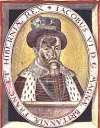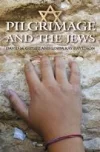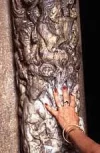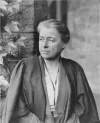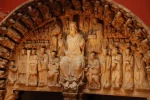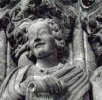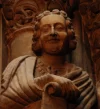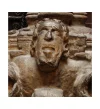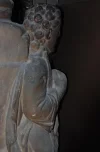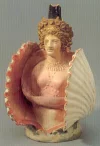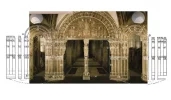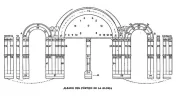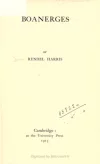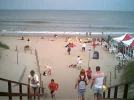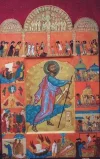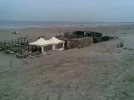PILGRIMSPLAZA
Active Member
update July 2010
In a christian (book) shop in The Hague:
Is there a book on the essence of The Santiago Enigma? - No!
Will such a book ever be written? - No!
Isn't that very strange? - Yes!
Why are you so sure about this? - Your question has been asked me twice before and I discussed it with a few bishops in America.
Pilgrimage is of all people, faiths, sferes and ages - for hunters, gatherers and smorgasbordians:
Er is geen weg naar de vrede; vrede is de weg - Simon Vinkenoog
Truth is a pathless land - Jiddu Krishnamurti
Summer 2009 continued on
http://the-santiago-enigma-continued.blogspot.com and http://king-early-days.blogspot.com
All my 200 forum posts introduced on http://pilgrimsplaza-pilgrimage-to-sant ... ogspot.com
21-5-9 NEW: The Santiago Enigma - clues
http://the-santiago-enigma-clues.blogspot.com
http://the-santiago-enigma-gateway.blogspot.com
Faces in the London Pórtico de la Gloria - breathtaking culmination of the camino
All these faces are cut out of pictures of the plaster copy in the Victoria & Albert Museum at London of the Pórtico de la Gloria in Saint James's cathedral at Santiago de Compostela in Spain. Courtesy and © (permission given on 22-5-9) of Mr. Gareth Thomas who took these on the eve of his pilgrimage from England through France to Santiago.
Quote of the year by my neighbour Erik Jan de Jong:
"The origin may be vague, but the veneration is real"
The Santiago Enigma
1. Why Santiago or Fisterra?
2. Why Saint James or Priscillian?
3. Why millions of secular pilgrims?
4. What Enigma in the Pórtico de la Gloria?
5. How jewish Jacobus became catholic James
6. More reviews of The Way of Saint James coming
7. Here is #1: Ja’akov en Jacobus – is the name a sign?
(by Mrs. Ria van der Pot & Mrs. Marianne Lodder, posted below on March 31st, 2008, 5:25 pm)
This beautiful Santiago Forum, ‘where past pilgrims share and future pilgrims learn’, is the best place to ask these questions that have kept me wondering over the last quarter of a century. The recent reprint of The Way of Saint James by Ms Georgiana Goddard King is a good occasion because Ms King deals with some of these questions. This is only a small part of her very rich classic on the history of art and the cult of Santiago. You could ask: Why now? Hasn’t this been discussed before? Not, I must say, to my knowledge, except by Ms King; speaking of enigmas!
See for reviews of Ms King’s book in the section Pilgrim Books: http://www.pilgrimage-to-santiago.com/b ... c3657.html .
The Santiago Enigma
Arriving in Santiago on Plaza de Obradoiro and entering Saint James’ cathedral gives one a very strong almost overwhelming feeling. Back home you may keep wondering for years –like I did- why that feeling stays so strong? Well, perhaps because there is more than meets the eye at first glance. You may be seeing more than you realize. In these chapters we are going to explore those images and questions and we would like you to join us. This will be a wonderful trip into the magic realm of the oldest stories within the usual ones.
We’ll give you some clues to discover this Enigma of Santiago in the narthex of Saint James’ house and other intriguing aspects. All you have to do is sit down with your back against the wall –like I did in 1983- and scan that stone bible for some time, open your hearts and minds and read master Matthew’s great message about yourself. You may share your impressions and feelings with your fellow pilgrims here if you like. It would help if you could read Ms King’s Way of Saint James before you leave! On-line flip books and pdf files make that easy and comfortable.
1. Why Santiago or Fisterra?
What is it that compels pilgrims through the ages to journey to the end of the world as it was known to mediaeval western society? What enigma is Santiago harbouring? What is happening at Fisterra? Why do people want to go west? Even ¡Ultreya! means: Go west as far (ultra) as possible
2. Why Saint James or Priscillian?
The Camino is said to be the burial route for Saint James from the Holy Land as well as for another martyr Priscillian, who was beheaded at Trier (Trèves, in Germany) in 385. Does it matter whose bones are buried in Santiago or Mondoñedo? Is it not more important that they shared (and this we can agree on) the aspects of the end of our mortal lives, of going to where our then known world ended and the sun sets, of the only certainty in life: death?
3. Why millions of secular pilgrims?
Thousands per year? Of course! Tens of thousands? Why not! Hundreds of thousands? Maybe! But millions!? There must be something there which compels and attracts so many secular pilgrims!
4. What enigma harbours the Pórtico de la Gloria?
Sitting with my back against the wall in the narthex back in 1983 I suddenly saw the message contained in master Matthew’s stone bible. Only recently when I was answering a post on Priscillian in this forum I completely understood that it works like a two sided mirror that talks back. Ms King gives us a clue in rather vague words but you can see with your own eyes what’s going on there. If you can read her book first you will, however, be better prepared! Read for instance in Volume 3 on The Mortal Twin. On-line flip books and flat text pdf files make it easy and comfortable. Also see http://www.pilgrimage-to-santiago.com/b ... c3915.html .
5. How jewish Jacobus became catholic James
or: 5a. How jewish Ja'akov became roman Jacobus and catholic James, or: 5b. How James became jacobean
Not an enigma but a very interesting question is how the NT-apostle Jacobus came to be named James. He was the brother (Ms King even calls him a twin) of Christ and second-in-command after Him. Was the name James given deliberately or did it develop in time and language? Is it perhaps connected with his postmortem developing of faith from jewish to christian?
Elsewhere in this forum jacobean names for sheep and flowers are already being discussed. As will be explained below he was most likely named after the OT-patriarch Jacob (of Jacob’s ladder and Bethel). Recently I found this nice picture (below) of IACOBUS VI D.G. MAGNÆ of BRITANNIÆ, FRANCE ET HIBERNIÆ REX and I wondered why he wasn't called James. Please let us know if you've read other books or found more posts on this forum that answer these fascinating questions!
This book may also offer more clues online: Aliens and Sojourners: Self as Other in Early Christianity - by Benjamin H. Dunning - "Early Christians spoke about themselves as resident aliens, strangers, and sojourners, asserting that otherness is a fundamental part of being Christian. But why did they do so and to what ends? How did Christians' claim to foreign status situate them with respect to each other and to larger Roman world as the new movement grew and struggled to make sense of its own boundaries?" [...]
"Through close readings of ancient Christian texts such as Hebrews, 1 Peter, the Shepherd of Hermas, and the Epistle to Diognetus, Dunning examines the markedly different ways that Christians used the language of their own marginality, articulating a range of options for what it means to be Christian in relation to the Roman social order."
Also reviewed in BMCR 2010.05.24: http://bmcr.brynmawr.edu/2010/2010-05-24.html & http://books.google.com/books?id=9I1hEy ... navlinks_s
5a. How jewish Ja'akov became roman Jacobus and catholic James
See the first two pictures below; is this a coïncidence or is there more than meets the eye? Towards the end of Summer 2008 I found clear answers in part ONE chapter 6 The formation of Christianity in The Messianic Legacy (sequel to The Holy Blood and The Holy Grail) by Baigent, Leigh & Lincoln, 1986, ISBN 0-552-13182-2. At first sight we 'believe' that the observations of our three heroes are to the point and making sense, so please enlighten us if they don't! http://www.alibris.co.uk/booksearch?qwo ... ng*buyused price: €1,51 or more.
[94] 6 THE FORMATION OF CHRISTIANITY
[95] Acts offers a more or less reliable historic account of Paul's dispute with the Nazarean Party, which would culminate in nothing less than an entirely new religion.
[96] By A.D. 38, Jesus was being openly proclaimed as the Messiah -- not the Son of God but simply the rightful and anointed king -- by Nazarean refugees, or perhaps established communities, as far away as Antioch. It was here, in the Syrian capital far to the north of Damascus, that the term 'Christian' was to be applied to them for the first time. Until then, they had simply been called Nazareans. And they continued to be called Nazareans elsewhere -- especially Jerusalem -- for many years.
In A.D. 38, a centralised Nazarean authority was already well established in Jerusalem. By later Christian chroniclers, this administrative hierarchy was to become known as 'the Early Church'. Its most famous member, was, of course, Peter. Its official head, [97] however, conspicuously neglected by later tradition, was Jesus's brother Jacob, known subsequently as Saint James, or James the Just. By this time, the Magdalene, the Virgin and others of those closest to Jesus had disappeared, and there is no further mention of them in scriptural accounts. It is certainly reasonable to suppose that later assertions are accurate and that they sought refuge in exile. What is significant, however, is that it is not Peter, but Jesus's brother James who presides over the 'Church' in Jerusalem. Quite clearly, some principle of dynastic succession is at work. And it can hardly be coincidental that James is referred to as 'Zadok'.4 [98] At last, around A.D. 62-5, James, head of the Nazarean Party in Jerusalem, was seized and executed.
-----------------------------------------------------------------------------------------------------
[455] Eisenman, R.H., Maccabees, Zadokites, Christians and Qumran (Leiden, 1983)
--- James the Just in the Habakkuk Pesher (Leiden, 1986)
[469] 4 Eisenman, Maccabeus …, p.5, referring to Eusibius, History 2:23. Note that in Arabic James is Saddiq Ja'aqob (Eisler, Messiah Jesus, p.499).
More in http://king-early-days.blogspot.com
Also see: http://www.mystae.com/restricted/reflec ... hurch.html :
(3) James the Just
"The disciples said to Jesus, 'We know that you are going to leave us. Who will be our leader?' - Jesus said to them, 'No matter where you are, you are to go to James the Just, for whose sake heaven and earth came into being.'" - Thomas Logion 12
James' title, the Just or "Righteous One" (Zaddik) was borne by claimants to the High Priesthood, a lineage that dated back to the time of King David. - James is an English rendition of the Hebrew Jacob by which he would have been known by his Jewish contemporaries.
"Tyndale was...a good Oxford-Cambridge trained Greek scholar and based his translation on the 3rd (1522) edition of Erasmus' Greek text (which later was to be called the textus receptus). He consistently rendered the Greek IAKOBOS as 'James.' Thus, in the first chapter of 'The epistle off Paul unto the Gallathyans' he has Paul say: 'Then after thre yeare I returned to Jerusalem and abode with hym xv dayes / non other off the Apostles sawe I / save James the lordes brother.'
"It should be noted that the text was printed on the continent in German Gothic script, so there was as yet no distinction between a capital 'I' & a capital 'J.' Thus, Tyndale really rendered IAKOBOS as IAMES." - Mahlon Smith (CrossTalk) --- The first used of James in place of Jacob may have occurred in John Wycliff's English translation of the Bible ca. 1375 CE.
PS: 1-10-8 Yesterday I was advised the Heidelberger catechismus for more clear answers on short questions. It looks promising but it still may take some time!
6. Already 14 reviews of The Way of Saint James
Almost four years ago I started collecting reviews from pilgrim friends. We already have 14 contributions (mostly in Dutch) that will follow here as soon as possible after getting permission and translation. Now we start with one that answers some questions on naming James after Jacobus or Jacob under the title: "Ja’akov and Jacobus - is the name a sign?" It was posted below on March 31st, 2008, 5:25 pm after being translated into English, which proved a little difficult with the names of Jacob, Jacobus and James, as Peter foresaw!
&&&&&&&&&&&&&&&&&&&&&
More reviews will follow asap.
&&&&&&&&&&&&&&&&&&&&&
To all pilgrims:
Please read The Way of Saint James before you leave* and write a review on any aspect.
Thank you very much!
Geert
* When you read it after returning home you'll surely want to set out right away again!
The Way of Saint James
For comfortable flip book reading:
http://www.openlibrary.org/details/wayo ... 01kinguoft ; http://www.openlibrary.org/details/wayo ... 02kinguoft ; http://www.openlibrary.org/details/wayo ... 03kinguoft ;
For an easy and quick browse through all the flat texts:
http://elcaminosantiago.com/PDF/Way_of_ ... mes_01.txt ;
http://elcaminosantiago.com/PDF/Way_of_ ... mes_02.txt ;
http://elcaminosantiago.com/PDF/Way_of_ ... mes_03.txt ;
To the full index http://pilgrimsplaza-king-index.blogspot.com ;
To my English home page http://king-early-days.blogspot.com ;
To my Dutch website home page http://www.pelgrimspaden.nl ;
To my e-mail address in all my 29 internet weblogs > Comments 1.
For ordering the reprint from the source: http://www.pilgrimsprocess.com/events.htm
Also see http://www.pilgrimage-to-santiago.com/b ... c3657.html and http://www.pilgrimage-to-santiago.com/b ... tml#p20259
And at last for our Dutch pilgrims: http://santiago.nl/links.php
and http://www.santiago.nl/nieuws_20080414_ ... enigma.php
New 21-6-9: Some comments on The Santiago Enigma by PILGRIMSPLAZA on June 21st, 2009, 10:03 pm on http://www.pilgrimage-to-santiago.com/b ... tml#p37089
Discussions to be continued on http://king-early-days.blogspot.com
In a christian (book) shop in The Hague:
Is there a book on the essence of The Santiago Enigma? - No!
Will such a book ever be written? - No!
Isn't that very strange? - Yes!
Why are you so sure about this? - Your question has been asked me twice before and I discussed it with a few bishops in America.
Pilgrimage is of all people, faiths, sferes and ages - for hunters, gatherers and smorgasbordians:
Er is geen weg naar de vrede; vrede is de weg - Simon Vinkenoog
Truth is a pathless land - Jiddu Krishnamurti
Summer 2009 continued on
http://the-santiago-enigma-continued.blogspot.com and http://king-early-days.blogspot.com
All my 200 forum posts introduced on http://pilgrimsplaza-pilgrimage-to-sant ... ogspot.com
21-5-9 NEW: The Santiago Enigma - clues
http://the-santiago-enigma-clues.blogspot.com
http://the-santiago-enigma-gateway.blogspot.com
Faces in the London Pórtico de la Gloria - breathtaking culmination of the camino
All these faces are cut out of pictures of the plaster copy in the Victoria & Albert Museum at London of the Pórtico de la Gloria in Saint James's cathedral at Santiago de Compostela in Spain. Courtesy and © (permission given on 22-5-9) of Mr. Gareth Thomas who took these on the eve of his pilgrimage from England through France to Santiago.
Quote of the year by my neighbour Erik Jan de Jong:
"The origin may be vague, but the veneration is real"
The Santiago Enigma
1. Why Santiago or Fisterra?
2. Why Saint James or Priscillian?
3. Why millions of secular pilgrims?
4. What Enigma in the Pórtico de la Gloria?
5. How jewish Jacobus became catholic James
6. More reviews of The Way of Saint James coming
7. Here is #1: Ja’akov en Jacobus – is the name a sign?
(by Mrs. Ria van der Pot & Mrs. Marianne Lodder, posted below on March 31st, 2008, 5:25 pm)
This beautiful Santiago Forum, ‘where past pilgrims share and future pilgrims learn’, is the best place to ask these questions that have kept me wondering over the last quarter of a century. The recent reprint of The Way of Saint James by Ms Georgiana Goddard King is a good occasion because Ms King deals with some of these questions. This is only a small part of her very rich classic on the history of art and the cult of Santiago. You could ask: Why now? Hasn’t this been discussed before? Not, I must say, to my knowledge, except by Ms King; speaking of enigmas!
See for reviews of Ms King’s book in the section Pilgrim Books: http://www.pilgrimage-to-santiago.com/b ... c3657.html .
The Santiago Enigma
Arriving in Santiago on Plaza de Obradoiro and entering Saint James’ cathedral gives one a very strong almost overwhelming feeling. Back home you may keep wondering for years –like I did- why that feeling stays so strong? Well, perhaps because there is more than meets the eye at first glance. You may be seeing more than you realize. In these chapters we are going to explore those images and questions and we would like you to join us. This will be a wonderful trip into the magic realm of the oldest stories within the usual ones.
We’ll give you some clues to discover this Enigma of Santiago in the narthex of Saint James’ house and other intriguing aspects. All you have to do is sit down with your back against the wall –like I did in 1983- and scan that stone bible for some time, open your hearts and minds and read master Matthew’s great message about yourself. You may share your impressions and feelings with your fellow pilgrims here if you like. It would help if you could read Ms King’s Way of Saint James before you leave! On-line flip books and pdf files make that easy and comfortable.
1. Why Santiago or Fisterra?
What is it that compels pilgrims through the ages to journey to the end of the world as it was known to mediaeval western society? What enigma is Santiago harbouring? What is happening at Fisterra? Why do people want to go west? Even ¡Ultreya! means: Go west as far (ultra) as possible
2. Why Saint James or Priscillian?
The Camino is said to be the burial route for Saint James from the Holy Land as well as for another martyr Priscillian, who was beheaded at Trier (Trèves, in Germany) in 385. Does it matter whose bones are buried in Santiago or Mondoñedo? Is it not more important that they shared (and this we can agree on) the aspects of the end of our mortal lives, of going to where our then known world ended and the sun sets, of the only certainty in life: death?
3. Why millions of secular pilgrims?
Thousands per year? Of course! Tens of thousands? Why not! Hundreds of thousands? Maybe! But millions!? There must be something there which compels and attracts so many secular pilgrims!
4. What enigma harbours the Pórtico de la Gloria?
Sitting with my back against the wall in the narthex back in 1983 I suddenly saw the message contained in master Matthew’s stone bible. Only recently when I was answering a post on Priscillian in this forum I completely understood that it works like a two sided mirror that talks back. Ms King gives us a clue in rather vague words but you can see with your own eyes what’s going on there. If you can read her book first you will, however, be better prepared! Read for instance in Volume 3 on The Mortal Twin. On-line flip books and flat text pdf files make it easy and comfortable. Also see http://www.pilgrimage-to-santiago.com/b ... c3915.html .
5. How jewish Jacobus became catholic James
or: 5a. How jewish Ja'akov became roman Jacobus and catholic James, or: 5b. How James became jacobean
Not an enigma but a very interesting question is how the NT-apostle Jacobus came to be named James. He was the brother (Ms King even calls him a twin) of Christ and second-in-command after Him. Was the name James given deliberately or did it develop in time and language? Is it perhaps connected with his postmortem developing of faith from jewish to christian?
Elsewhere in this forum jacobean names for sheep and flowers are already being discussed. As will be explained below he was most likely named after the OT-patriarch Jacob (of Jacob’s ladder and Bethel). Recently I found this nice picture (below) of IACOBUS VI D.G. MAGNÆ of BRITANNIÆ, FRANCE ET HIBERNIÆ REX and I wondered why he wasn't called James. Please let us know if you've read other books or found more posts on this forum that answer these fascinating questions!
This book may also offer more clues online: Aliens and Sojourners: Self as Other in Early Christianity - by Benjamin H. Dunning - "Early Christians spoke about themselves as resident aliens, strangers, and sojourners, asserting that otherness is a fundamental part of being Christian. But why did they do so and to what ends? How did Christians' claim to foreign status situate them with respect to each other and to larger Roman world as the new movement grew and struggled to make sense of its own boundaries?" [...]
"Through close readings of ancient Christian texts such as Hebrews, 1 Peter, the Shepherd of Hermas, and the Epistle to Diognetus, Dunning examines the markedly different ways that Christians used the language of their own marginality, articulating a range of options for what it means to be Christian in relation to the Roman social order."
Also reviewed in BMCR 2010.05.24: http://bmcr.brynmawr.edu/2010/2010-05-24.html & http://books.google.com/books?id=9I1hEy ... navlinks_s
5a. How jewish Ja'akov became roman Jacobus and catholic James
See the first two pictures below; is this a coïncidence or is there more than meets the eye? Towards the end of Summer 2008 I found clear answers in part ONE chapter 6 The formation of Christianity in The Messianic Legacy (sequel to The Holy Blood and The Holy Grail) by Baigent, Leigh & Lincoln, 1986, ISBN 0-552-13182-2. At first sight we 'believe' that the observations of our three heroes are to the point and making sense, so please enlighten us if they don't! http://www.alibris.co.uk/booksearch?qwo ... ng*buyused price: €1,51 or more.
[94] 6 THE FORMATION OF CHRISTIANITY
[95] Acts offers a more or less reliable historic account of Paul's dispute with the Nazarean Party, which would culminate in nothing less than an entirely new religion.
[96] By A.D. 38, Jesus was being openly proclaimed as the Messiah -- not the Son of God but simply the rightful and anointed king -- by Nazarean refugees, or perhaps established communities, as far away as Antioch. It was here, in the Syrian capital far to the north of Damascus, that the term 'Christian' was to be applied to them for the first time. Until then, they had simply been called Nazareans. And they continued to be called Nazareans elsewhere -- especially Jerusalem -- for many years.
In A.D. 38, a centralised Nazarean authority was already well established in Jerusalem. By later Christian chroniclers, this administrative hierarchy was to become known as 'the Early Church'. Its most famous member, was, of course, Peter. Its official head, [97] however, conspicuously neglected by later tradition, was Jesus's brother Jacob, known subsequently as Saint James, or James the Just. By this time, the Magdalene, the Virgin and others of those closest to Jesus had disappeared, and there is no further mention of them in scriptural accounts. It is certainly reasonable to suppose that later assertions are accurate and that they sought refuge in exile. What is significant, however, is that it is not Peter, but Jesus's brother James who presides over the 'Church' in Jerusalem. Quite clearly, some principle of dynastic succession is at work. And it can hardly be coincidental that James is referred to as 'Zadok'.4 [98] At last, around A.D. 62-5, James, head of the Nazarean Party in Jerusalem, was seized and executed.
-----------------------------------------------------------------------------------------------------
[455] Eisenman, R.H., Maccabees, Zadokites, Christians and Qumran (Leiden, 1983)
--- James the Just in the Habakkuk Pesher (Leiden, 1986)
[469] 4 Eisenman, Maccabeus …, p.5, referring to Eusibius, History 2:23. Note that in Arabic James is Saddiq Ja'aqob (Eisler, Messiah Jesus, p.499).
More in http://king-early-days.blogspot.com
Also see: http://www.mystae.com/restricted/reflec ... hurch.html :
(3) James the Just
"The disciples said to Jesus, 'We know that you are going to leave us. Who will be our leader?' - Jesus said to them, 'No matter where you are, you are to go to James the Just, for whose sake heaven and earth came into being.'" - Thomas Logion 12
James' title, the Just or "Righteous One" (Zaddik) was borne by claimants to the High Priesthood, a lineage that dated back to the time of King David. - James is an English rendition of the Hebrew Jacob by which he would have been known by his Jewish contemporaries.
"Tyndale was...a good Oxford-Cambridge trained Greek scholar and based his translation on the 3rd (1522) edition of Erasmus' Greek text (which later was to be called the textus receptus). He consistently rendered the Greek IAKOBOS as 'James.' Thus, in the first chapter of 'The epistle off Paul unto the Gallathyans' he has Paul say: 'Then after thre yeare I returned to Jerusalem and abode with hym xv dayes / non other off the Apostles sawe I / save James the lordes brother.'
"It should be noted that the text was printed on the continent in German Gothic script, so there was as yet no distinction between a capital 'I' & a capital 'J.' Thus, Tyndale really rendered IAKOBOS as IAMES." - Mahlon Smith (CrossTalk) --- The first used of James in place of Jacob may have occurred in John Wycliff's English translation of the Bible ca. 1375 CE.
PS: 1-10-8 Yesterday I was advised the Heidelberger catechismus for more clear answers on short questions. It looks promising but it still may take some time!
6. Already 14 reviews of The Way of Saint James
Almost four years ago I started collecting reviews from pilgrim friends. We already have 14 contributions (mostly in Dutch) that will follow here as soon as possible after getting permission and translation. Now we start with one that answers some questions on naming James after Jacobus or Jacob under the title: "Ja’akov and Jacobus - is the name a sign?" It was posted below on March 31st, 2008, 5:25 pm after being translated into English, which proved a little difficult with the names of Jacob, Jacobus and James, as Peter foresaw!
&&&&&&&&&&&&&&&&&&&&&
More reviews will follow asap.
&&&&&&&&&&&&&&&&&&&&&
To all pilgrims:
Please read The Way of Saint James before you leave* and write a review on any aspect.
Thank you very much!
Geert
* When you read it after returning home you'll surely want to set out right away again!
The Way of Saint James
For comfortable flip book reading:
http://www.openlibrary.org/details/wayo ... 01kinguoft ; http://www.openlibrary.org/details/wayo ... 02kinguoft ; http://www.openlibrary.org/details/wayo ... 03kinguoft ;
For an easy and quick browse through all the flat texts:
http://elcaminosantiago.com/PDF/Way_of_ ... mes_01.txt ;
http://elcaminosantiago.com/PDF/Way_of_ ... mes_02.txt ;
http://elcaminosantiago.com/PDF/Way_of_ ... mes_03.txt ;
To the full index http://pilgrimsplaza-king-index.blogspot.com ;
To my English home page http://king-early-days.blogspot.com ;
To my Dutch website home page http://www.pelgrimspaden.nl ;
To my e-mail address in all my 29 internet weblogs > Comments 1.
For ordering the reprint from the source: http://www.pilgrimsprocess.com/events.htm
Also see http://www.pilgrimage-to-santiago.com/b ... c3657.html and http://www.pilgrimage-to-santiago.com/b ... tml#p20259
And at last for our Dutch pilgrims: http://santiago.nl/links.php
and http://www.santiago.nl/nieuws_20080414_ ... enigma.php
New 21-6-9: Some comments on The Santiago Enigma by PILGRIMSPLAZA on June 21st, 2009, 10:03 pm on http://www.pilgrimage-to-santiago.com/b ... tml#p37089
Discussions to be continued on http://king-early-days.blogspot.com



